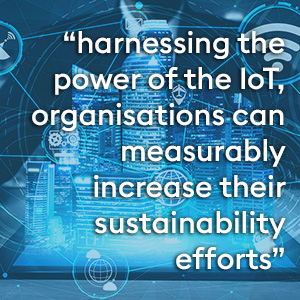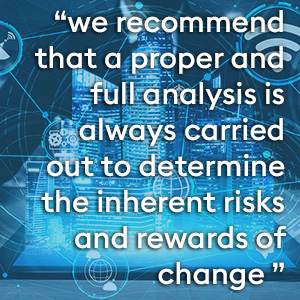How Internet of Things (IoT) is Transforming the Sustainability Landscape
As businesses strive to meet growing demands for environmental accountability from customers, shareholders and internal audiences alike, the Internet of Things (IoT) emerges as a growing force for good, enabling organisations to not only achieve sustainability targets, but to tear them up and think even more optimistically about their environmental goals.
In this article we investigate the pivotal role Internet of Things (IoT) plays in driving sustainable practices. From optimising resource use to enhancing energy efficiency, we explore how organisations are leveraging IoT technologies to address environmental challenges head-on, paving the way for a time when business efficiency and sustainability can truly go hand in hand.
What exactly is IoT?
 Although many people may have heard of the Internet of Things, and may even know what it means, not everyone will, so I thought we’d start with a quick explanation. For a task to be completed or decision to be made a cascade of actions and reactions is required. The IoT is a network of interconnected physical devices that exchange data with one another to monitor actions and to react to them, completing the task or making the decision together, improving efficiency and making life simpler.
Although many people may have heard of the Internet of Things, and may even know what it means, not everyone will, so I thought we’d start with a quick explanation. For a task to be completed or decision to be made a cascade of actions and reactions is required. The IoT is a network of interconnected physical devices that exchange data with one another to monitor actions and to react to them, completing the task or making the decision together, improving efficiency and making life simpler.
If this explanation is too theoretical, an example may help: a sensor-filled smart fridge can identify when a family has run out of milk, automatically communicating this to their online Tesco account to put milk on that week’s shopping order, and sending a message to the homeowner’s phone to let them know that the order has been placed and when they can expect delivery.
In the commercial world, let’s now use the retail sector as an example, IoT could be used to create intelligent inventory management systems. Traditionally, inventory has been a time-consuming – and potentially boring – manual task. It’s often a task that will either take staff, who could be serving customers and making money for the business, off the shop floor, or require a lucky staff member or two to stay late after the shop is closed to complete it. IoT could use smart shelving with weight sensors to monitor when items are removed and therefore calculate the stock levels on the shop floor. When stock falls below a certain threshold this will automatically trigger a restocking process, sending an alert to management or automatically placing orders with chosen suppliers. This is just-in-time (JIT) management in its purest form – reliable, trusted, automated systems can provide current stock levels for all products in real time. Beyond this, the IoT system could collect data over a set period to define shopping patterns and popular products so the retailer can confidently make commercial decisions on stock levels, staffing levels and schedules, and identify when higher purchase volumes are needed so the business can benefit from any bulk buying discounts available from suppliers.
 The Internet of Things represents an unprecedented opportunity to improve visibility and management capabilities, allowing businesses to monitor resource usage, optimise operations, and reduce waste.
The Internet of Things represents an unprecedented opportunity to improve visibility and management capabilities, allowing businesses to monitor resource usage, optimise operations, and reduce waste.
By harnessing the power of the IoT, organisations can measurably increase their sustainability efforts, transforming the data they collect in the process into actionable insights that drive wide-reaching change, efficiencies and strategies that will have a meaningful environmental impact.
Questions About the Impact of IoT on Corporate Sustainability Efforts
Just as the drive towards electric vehicle use is increasingly coming up against the argument that their production creates a negative environmental impact of its own, we see questions raised regarding IoT’s role in corporate sustainability efforts. The same connected devices that could save time, effort and waste also pose environmental challenges in their production, operation and disposal. To address these concerns, organisations are increasingly focused on the entire lifecycle of IoT devices, from eco-friendly design and energy-efficient operation to responsible recycling and waste management. A well thought out and considered business case is now a sensible first step to ensure that the IoT’s sustainability benefits are not overshadowed by its environmental footprint, and that any questions raised by internal or external stakeholders can be met with clear and concise answers.
IoT’s Role in Reducing Your Carbon Footprint
One of the most significant contributions the Internet of Things makes to sustainability lies in its ability to enhance energy efficiency, something on the minds of many businesses right now given the instability of energy pricing over the last year. IoT applications in smart buildings, energy grids, and industrial processes all enable precise monitoring and control of energy usage. Smart sensors can optimise lighting, heating, and cooling systems to ensure that they are only being used when needed, reducing unnecessary energy consumption as well as subsequent bills. Anything a business can do to reduce its energy consumption will have a positive impact on its carbon footprint, due to the significant environmental cost still attached to most energy production.
How IoT Can Enhance Sustainability Decision Making
The wealth of data generated by IoT devices represents a wealth of opportunity for any organisation’s sustainability efforts, and the collection, analysis, and interpretation of this data can provide deep insights into environmental performance. Organisations can leverage this data to track their sustainability metrics, set informed targets, and measure the effectiveness of their green initiatives, ensuring that their sustainability strategies are data-driven, evidenced, and results-oriented.
Balancing IoT Innovation with the Inherent Risks
 While the Internet of Things offers transformative potential for any company’s environmental credentials, it also presents a wide variety of challenges that require thoughtful navigation. Issues such as data security, privacy, and the ethical use of technology are at the forefront of these challenges. So, on top of the sustainability counterargument, organisations must consider a whole host of cause-and-effect issues before running headlong into company-wide IoT use. This is likely to involve the implementation of robust cybersecurity measures, new data privacy policies, and taking steps to foster an ethical culture that prioritises sustainable and responsible IoT deployment. Over the years we have seen many organisations chasing after the latest ‘shiny object’, often to their detriment. This is why we recommend that a proper and full analysis is always carried out to determine the inherent risks and rewards of change to ensure that the first can be effectively mitigated and the second can be maximised.
While the Internet of Things offers transformative potential for any company’s environmental credentials, it also presents a wide variety of challenges that require thoughtful navigation. Issues such as data security, privacy, and the ethical use of technology are at the forefront of these challenges. So, on top of the sustainability counterargument, organisations must consider a whole host of cause-and-effect issues before running headlong into company-wide IoT use. This is likely to involve the implementation of robust cybersecurity measures, new data privacy policies, and taking steps to foster an ethical culture that prioritises sustainable and responsible IoT deployment. Over the years we have seen many organisations chasing after the latest ‘shiny object’, often to their detriment. This is why we recommend that a proper and full analysis is always carried out to determine the inherent risks and rewards of change to ensure that the first can be effectively mitigated and the second can be maximised.
The Evolving Landscape of IoT and Sustainability
This is a fast-moving discipline. Looking ahead, the innovative intersection between IoT and sustainability is poised for further explosive change. Emerging trends such as the integration of AI within so many areas of IoT, the development of low-power IoT devices, and the advancement of 5G technology to improve connectivity and speed are all set to amplify the impact of IoT within the corporate environment. As with any transformative advancement in the business world, organisations that stay attuned to these trends and proactively incorporate sustainable IoT solutions within their makeup will not only contribute to environmental preservation but also gain a competitive advantage in the evolving business landscape in which they trade.
Conclusion
Should businesses be embracing the Internet of Things in their quest for improved sustainability, alongside their traditional growth expectations?
There is no doubt that IoT has the capacity to help organisations to achieve these diverse aspirations, offering solutions that are not only technologically advanced but also environmentally conscious. Embracing IoT for its sustainability potential is not just an option, it’s an imperative in a world where environmental responsibility increasingly guides buyer and investor decision making.
At Assembly we have been watching the growth of this discipline with interest. So, if you are interested in determining whether the incorporation of IoT might be beneficial for your organisation, then contact us today.
Telephone: +44 (0)20 3795 6880
Have you enjoyed this blog? If so, why not share it on your preferred social media platform?






